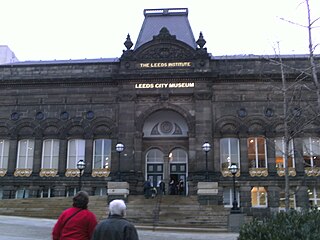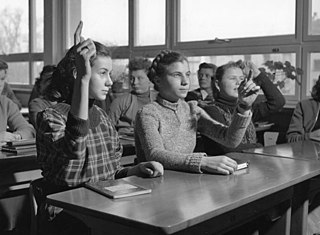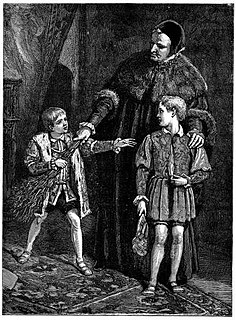 W
WEmile, or On Education is a treatise on the nature of education and on the nature of man written by Jean-Jacques Rousseau, who considered it to be the "best and most important" of all his writings. Due to a section of the book entitled "Profession of Faith of the Savoyard Vicar", Emile was banned in Paris and Geneva and was publicly burned in 1762, the year of its first publication. During the French Revolution, Emile served as the inspiration for what became a new national system of education.
 W
WFemale education is a catch-all term of a complex set of issues and debates surrounding education for girls and women. It is frequently called girl's education or women's education. It includes areas of gender equality and access to education. The education of women and girls is important connection to the alleviation of poverty. Broader related topics include single-sex education and religious education for women, in which education is divided gender lines.
 W
WFemale education in STEM includes child and adult female represented in the fields of science, technology, engineering, and mathematics (STEM). In 2017, 33% of students in STEM fields were women.
 W
WThe history of education in Missouri deals with schooling over two centuries, from the settlements In the early 19th century to the present. It covers students, teachers, schools, and educational policies.
 W
WThe roots of law, legal thought and education in Serbia go back to the 13th century. This is owed to Rastko Nemanjić, who was declared a saint under the name St. Sava. Rastko, the brother of the first Serbian king Stefan Nemanjić, was the founder of not only the ecclesiastical independence, but he also has instituted the Serbian education, literature, health, the legal system and science.
 W
WLilias Maitland (1862–1932) was one of the first women graduates from a Scottish University at the University of Edinburgh who graduated in 1893.
 W
WMechanics' institutes are educational establishments, originally formed to provide adult education, particularly in technical subjects, to working men. Similar organisations are sometimes simply called "institutes". As such, they were often funded by local industrialists on the grounds that they would ultimately benefit from having more knowledgeable and skilled employees. The mechanics' institutes were used as "libraries" for the adult working class, and provided them with an alternative pastime to gambling and drinking in pubs.
 W
WA normal school is an institution created to train high school graduates to be teachers by educating them in the norms of pedagogy and curriculum. Most such schools, where they still exist, are now denominated "teacher-training colleges" or "teachers' colleges" and may be organized as part of a comprehensive university. Normal schools in the United States, Canada and Argentina trained teachers for primary schools, while in continental Europe, the equivalent colleges educated teachers for primary, secondary and tertiary schools.
 W
WOne-room schools were commonplace throughout rural portions of various countries, including Prussia, Norway, Sweden, the United States, Canada, Australia, New Zealand, the United Kingdom, Ireland, and Spain. In most rural and small town schools, all of the students met in a single room. There, a single teacher taught academic basics to several grade levels of elementary-age children. While in many areas one-room schools are no longer used, it is not uncommon for them to remain in developing nations and rural or remote areas. Examples include remote parts of the American West, the Falklands, and the Shetland Islands.
 W
WThe Ratio atque Institutio Studiorum Societatis Iesu, often abbreviated as Ratio Studiorum, was a document that standardized the globally influential system of Jesuit education in 1599. It was a collection of regulations for school officials and teachers. The Ratio Studiorum relied on the classical subjects and did not contain any provisions for elementary education. The document was revised in 1832, still built upon the classical subjects but giving more attention to the study of native languages of the students, history, geography, mathematics, and the natural sciences.
 W
WA sand table uses constrained sand for modelling or educational purposes. The original version of a sand table may be the abax used by early Greek students. In the modern era, one common use for a sand table is to make terrain models for military planning and wargaming.
 W
WThe Seven Sages or Seven Wise Men was the title given by classical Greek tradition to seven philosophers, statesmen, and law-givers of the 6th century BC who were renowned for their wisdom.
 W
WSloyd, also known as Educational sloyd, is a system of handicraft-based education started by Uno Cygnaeus in Finland in 1865. The system was further refined and promoted worldwide, and was taught in the United States until the early 20th Century. It is still taught as a compulsory subject in Finnish, Danish, Swedish and Norwegian schools.
 W
WThe Society for Promoting Christian Knowledge (SPCK) is a UK-based Christian charity. Founded in 1698 by Thomas Bray, it has worked for over 300 years to increase awareness of the Christian faith in the UK and across the world.
 W
WThe Socratic method is a form of cooperative argumentative dialogue between individuals, based on asking and answering questions to stimulate critical thinking and to draw out ideas and underlying presuppositions. It is named after the Classical Greek philosopher Socrates and is introduced by him in Plato's Theaetetus as midwifery (maieutics) because it is employed to bring out definitions implicit in the interlocutors' beliefs, or to help them further their understanding.
 W
WStudent voice is "any expression of any learner regarding anything related to education" and describes "the distinct perspectives and actions of young people throughout schools focused on education. Tech educator Dennis Harper writes, "Student voice is giving students the ability to influence learning to include policies, programs, contexts and principles."
 W
WThis is a timeline of women's education.
 W
WThe trivium is the lower division of the seven liberal arts and comprises grammar, logic, and rhetoric.
 W
WA two-room schoolhouse is a larger version of the one-room schoolhouse, with many of the same characteristics, providing the facility for primary and secondary education in a small community. While providing the same function as a contemporary primary school or secondary school building, a small multi-room school house is more similar to a one-room schoolhouse, both being architecturally very simple structures. While once very common in rural areas of many countries, one and two-room schools have largely been replaced although some are still operating. Having a second classroom allowed for two teachers to operate at the school, serving a larger number of schoolchildren and/or more grade levels. Architecturally, they could be slightly more complex, but were still usually very simple. In some areas, a two-room school indicated the village or town was wealthier and more prosperous.
 W
WA Vindication of the Rights of Woman: with Strictures on Political and Moral Subjects (1792), written by the 18th-century British proto-feminist Mary Wollstonecraft, is one of the earliest works of feminist philosophy. In it, Wollstonecraft responds to those educational and political theorists of the 18th century who believed that women should not receive a rational education. She argues that women's education ought to match their position in society, and that they are essential to the nation because they raise its children and could act as respected "companions" to their husbands. Wollstonecraft maintains that women are human beings deserving of the same fundamental rights as men, and that treating them as mere ornaments or property for men undercuts the moral foundation of society.
 W
WThe German term Volksschule generally refers to compulsory education, denoting an educational institution every person is required to attend.
 W
WA whipping boy was a boy educated alongside a prince in early modern Europe, who received corporal punishment for the prince's transgressions in his presence. The prince was not punished himself because his royal status exceeded that of his tutor; seeing a friend punished would provide an equivalent motivation not to repeat the offence. An archaic proverb which captures a similar idea is "to beat a dog before a lion." Whipping was a common punishment of tutors at that time. There is little contemporary evidence for the existence of whipping boys, and evidence that some princes were indeed whipped by their tutors, although Nicholas Orme suggests that nobles might have been beaten less often than other pupils. Some historians regard whipping boys as entirely mythical; others suggest they applied only in the case of a boy king, protected by divine right, and not to mere princes.